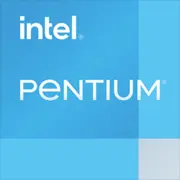Intel Pentium 3825U

Intel Pentium 3825U: A Budget Processor for Everyday Tasks
Analysis of Capabilities and Relevance in 2025
Architecture and Technology Process: The Foundation of Broadwell
The Intel Pentium 3825U processor, released in 2015, is based on the Broadwell microarchitecture (5th generation Intel Core) and is manufactured using a 14nm process technology. It was one of the first Intel chips to implement 14nm technology, which reduced energy consumption without a significant loss in performance.
Key Specifications:
- Cores and Threads: 2 cores, 4 threads (thanks to Hyper-Threading).
- Clock Speeds: Base clock of 1.9 GHz, maximum turbo boost of 2.5 GHz.
- Cache: L3 cache of 2 MB, which is modest even for its time, but sufficient for light tasks.
- iGPU: Intel HD Graphics (Broadwell GT1) with 12 execution units (EUs) and a frequency of up to 850 MHz. Supports DirectX 11.2 and 4K@60 Hz resolution (via DisplayPort).
Architecture Features:
- Energy Efficiency: The 14nm process technology and TDP of 15W make it ideal for ultrabooks.
- Outdated Technologies: Lack of support for AVX2 and modern AI instructions (e.g., DL Boost) limits its use in machine learning tasks.
Power Consumption and TDP: A Balance Between Performance and Autonomy
A TDP of 15W indicates that this processor is designed for passive or low-power active cooling. This means:
- Pros: Laptops with this CPU are slim (up to 18 mm) and lightweight (1.2–1.5 kg).
- Cons: Extended loads (e.g., video rendering) can lead to throttling — a drop in frequency due to overheating.
Power-Saving Technologies:
- Intel SpeedStep: Dynamically adjusts frequency based on load.
- C-states: Powers down unused cores to conserve charge.
Performance: What Can the Pentium 3825U Do in 2025?
Geekbench 6 Scores:
- Single-Core: 296 — comparable to the Intel Core i3-5005U (2015).
- Multi-Core: 580 — weaker than budget AMD Ryzen 3 5300U (2020), which scores around 1200 points.
Real-World Scenarios:
1. Office Work:
- Google Docs, Excel, a browser with 10+ tabs — works comfortably, but slowdowns may occur when running Zoom simultaneously.
- Tip: Close background applications.
2. Multimedia:
- Playing 4K video (via YouTube or local files) — manages well if hardware decoding is used.
- Photo editing in Lightroom — slow but possible for basic corrections.
3. Gaming:
- Older games: Minecraft (30–40 FPS on low settings), CS:GO (25–30 FPS).
- Cloud gaming (GeForce NOW, Xbox Cloud) — an optimal option for modern titles.
Turbo Boost Mode:
- Temporary boost to 2.5 GHz helps with "bursty" loads (e.g., opening a heavy PDF), but is ineffective for prolonged tasks (video conversion).
Usage Scenarios: Who Is This Processor Suitable For?
- Students: For studies (typing, presentations, online courses).
- Office Workers: Document and email handling.
- Casual Users: Social media, music/video streaming.
- Not Suitable For: Gamers, video editors, engineers (CAD, 3D modeling).
Battery Life: How Long Will the Laptop Last?
Average battery life for devices with the Pentium 3825U is 6–8 hours under:
- Screen brightness of 150 nits.
- Active use of browser and office applications.
Factors That Reduce Battery Life:
- Running Chrome with 20+ tabs.
- Connecting external devices (HDD, USB gadgets).
Tip: Choose laptops with a battery of at least 45 Wh (e.g., Acer Aspire 5) — they retain a charge even after 2–3 years of use.
Comparison with Competitors
1. AMD A6-9220 (2017):
- Pros: Better graphics (Radeon R4).
- Cons: Higher power consumption (TDP 15W, but actual usage can reach 25W).
2. Intel Celeron N5100 (2021):
- Pros: Support for AVX2, modern 10nm technology.
- Cons: More expensive (laptops from $350).
3. Apple M1 (2020):
- A clear leader in performance and battery life, but starts at $999.
Conclusion: The Pentium 3825U remains relevant only in the budget segment (under $300), where alternatives are used devices or Chromebooks.
Pros and Cons
Strengths:
- Low cost of laptops (new models range from $250–$350).
- Sufficient performance for basic tasks.
- Compactness and quiet operation (fanless in some models).
Weaknesses:
- Outdated architecture: lags behind even budget processors of the 2020s.
- Limited multitasking: "hangs" when running several heavy applications simultaneously.
- Weak graphics: inability to game comfortably.
Recommendations for Choosing a Laptop
1. Type of Device:
- Ultrabook: For example, Lenovo IdeaPad Slim 3 — weighs 1.4 kg, portable.
- Budget Laptop: HP 15-dw2000 — 15.6" display, HDD + SSD slot.
2. What to Look For:
- RAM: At least 8 GB (DDR3L).
- Storage: Ensure it has an SSD (even 128 GB is enough for the OS).
- Screen: IPS panel with a resolution of 1920×1080.
3. What to Avoid:
- Versions with HDD instead of SSD.
- Models without support for Wi-Fi 5 (802.11ac).
Final Conclusion: Who Is the Pentium 3825U For?
This processor is suitable for those who:
- Are looking for the cheapest new laptop for basic tasks.
- Do not plan to run "heavy" programs or games.
- Value battery life and portability.
Key Benefits:
- Price under $350.
- Adequate performance for 80% of everyday tasks.
- Upgrade potential (add SSD or RAM).
Alternative: If your budget allows $400–500, it's better to choose a laptop with Intel Core i3-1215U or AMD Ryzen 3 7320U — they will last longer and not disappoint in performance.
This article is relevant as of April 2025. Prices are listed for new devices in the USA.
Basic
CPU Specifications
Memory Specifications
GPU Specifications
Miscellaneous
Benchmarks
Compared to Other CPU
Share in social media
Or Link To Us
<a href="https://cputronic.com/en/cpu/intel-pentium-3825u" target="_blank">Intel Pentium 3825U</a>